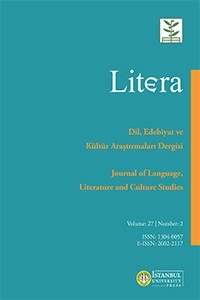Intellectio and Inventio in Turkish Poetry Translation
New Rhetorics has returned to the classical meaning of rhetoric as a science of discourse and not only as a study of literary figures. The contributions of contemporary linguistics, particularly pragmatics, to the analysis of discourse as «language in action» demonstrate the validity of the postulates of classical rhetoric. In this sense, it is perfectly possible to apply categories of rhetoric to the analysis of translation since it is a communicative activity that uses language as a means of transmission. However, it is convenient to overcome the traditional dedication at the most superficial level of elocutio and pay attention to other levels, be it before the performance of the discourse, such as intellectio, or being formants of it, such as inventio. We can consider the intellectio as the location of the author prior to the text from the point of view of field, mode and tenor. Inventio is an encyclopedia of topics and ways of treating them conditioned culturally and historically. The translation of a text can find problems at both levels that go beyond those strictly lexical, even if they end up being reflected in words. As an example, we use the translations into Spanish, with an intermediate language, of two poems by Ataol Behramoğlu originally in Turkish.
Keywords:
New rhetorics, intellectio, inventio, translation Ataol Behramoğlu,
___
- Albaladejo, T. & Chico Rico, F. (1998). La “intellectio” en la serie de las operaciones retóricas no constituyentes de discurso. Teoría/Crítica (5), 339-352.
- Arduini, S. (2000). Prolegómenos a una teoría general de las figuras. Murcia: Universidad de Murcia, Servicio de Publicaciones.
- Azaustre, A. & Casas, J. (1997). Manual de retórica española. Barcelona: Ariel. Nueva edición, 2015.
- Carpintero, R. (2013). La “localización” del traductor. en AA. VV.: Hijos de Babel. Reflexiones sobre el oficio de traductor en el siglo XXI (pp. 85-92). Madrid: Fórcola.
- Carpintero, R. (2017). Back to Basics: Transfer as a Metaphorical Process. Litera: Dil, Edebiyat ve Kültür Araştırmaları Dergisi, 27 (1), 1-21.
- Carpintero, R. (2018). Dispositio y compositio en la traducción de poesía turco-español. Trans. Revista de Traductología, 22, 99-114.
- Chico Rico, F. (1989). La intellectio. Notas sobre una sexta operación retórica. Castilla, Estudios de Literatura (14), 47-55.
- Chico Rico, F. (1995/1998). La intellectio en la Institutio Oratoria de Quintiliano: ingenium, iudicium, consilium y partes artis. En T. Albaladejo, E. Río y J. Caballero (eds.), Quintiliano, historia y actualidad de la retórica : actas del Congreso Internacional (pp. 493-502). Madrid y Calahorra, 14 al 18 de noviembre de 1995: Logroño : Instituto de Estudios Riojanos; Calahorra : Ayuntamiento de Calahorra, 1998
- Chico Rico, F. (2001). Retórica y traducción: Νόησις y πoίησις en la traducción del texto literario. En P. Y. Raccah y B. Saiz Noeda (eds.), Lenguas, literatura y traducción. Aproximaciones teóricas (pp. 257-285). Madrid: Arrecife.
- Chico Rico, F. (2002). La teoría de la traducción en la teoría retórica. Logo. Revista de Retórica y Teoría de la Comunicación (3), 25-40.
- García Berrio, A. (1984). Retórica como ciencia de la expresividad (Presupuestos para una retórica general). E.L.U.A. Estudios de Lingüística Universidad de Alicante (2), 7-59.
- Groupe μ. (1977). Rhétorique de la poésie. Lecture linéaire, lecture tabulaire. Paris: Éditions du Seuil, 1990.
- Grupo μ. (1970). Retórica general. (J. Victorio, trad.) Barcelona: Paidós, 1987 (edición española revisada).
- Hurtado Albir, A. (2001). Traducción y traductología. Introducción a la traductología. Madrid: Cátedra.
- Jakobson, R. (1958). Linguistics and Poetics. En T. Sebeok (ed.), Style in Language (pp. 350-377). Cambridge, Mass.: Technology Press of Massachusetts Institute of Technology ; London : John Wiley & Sons 1960.
- Jones, F. (1989). On Aboriginal Sufferance: A Process Model of Poetic Translating. Target, 1 (2), 183-199.
- Lefevere, A. (1992). Traducción, reescritura y la manipulación del canon literario. (M. Vidal y R. Álvarez, trads.) Salamanca: Colegio de España (1997).
- Lefevere, A. (1995/1998). La literatura comparada y la traducción. En M. J. Vega, y N. Carbonell , La literatura comparada: Principios y métodos (pp. 206-214). Madrid: Gredos.
- Leuven-Zwart, K. M. (1989). Translation and Original. Similarities and Dissimilarities I. Target (1), 151-181.
- Viaggio, S. (2004). Teoría General de la mediación interlingüe. Alicante: Servicio de Publicaciones de la Universidad de Alicante.
- Başlangıç: 1954
- Yayıncı: İstanbul Üniversitesi
